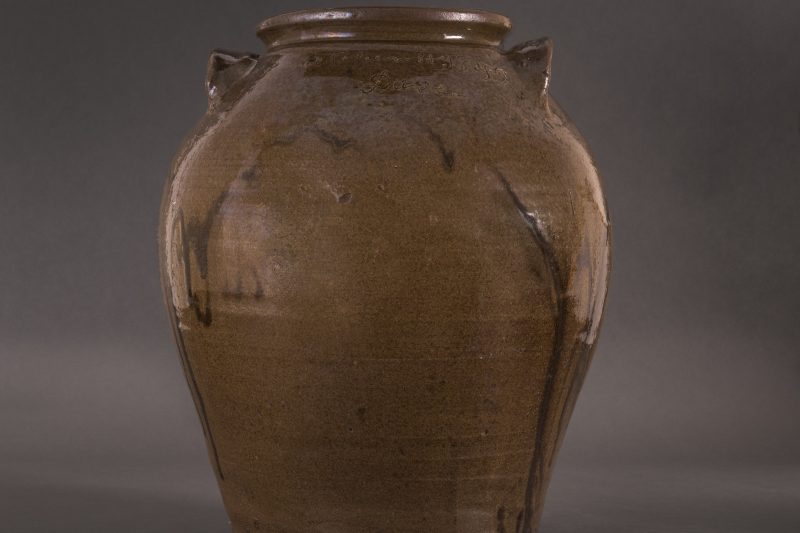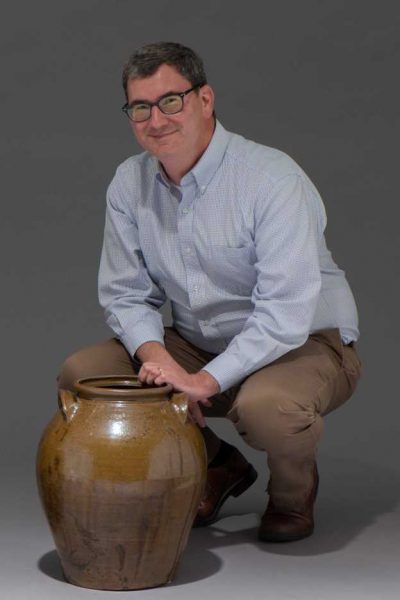More Than Meets the Eye A jar in the Reeves Collection tells the story of an African-American craftsman in Antebellum America.
David Drake, a potter working around Edgefield, South Carolina from the 1820s to the 1860s, and one of the best-known enslaved African-American craftspeople in the United States, made this jar.
Drake’s fame is partly due to the pots he made, which are skillfully thrown, large storage jars and jugs covered in a rich greenish-brown alkaline glaze. But his fame primarily rests on the fact that he inscribed many of his pieces with his name, the date he made the vessel and, in some rare instances, with short poems that reflected on his life and his world.
This particular pot is signed “October 31, 1849 Dave” on one side, and has the initials “L M” (for Lewis Miles, Drake’s owner) on the other. To the left of the date are five incised punctate marks indicating the jar’s capacity of five gallons. Drake made jars ranging in size from one gallon to enormous ones that could hold up to 40 gallons.
In signing his work, Drake, who seems to have gone by the name Dave, was almost unique among enslaved craftspeople. Enslaved people worked in almost every craft in the Southern United States, and it is likely that any wood, iron or fabric object made in the Southern United States before the Civil War was made at least in part with slave labor. However, in almost all cases, these craftspeople were anonymous. It is rare to even know the names of enslaved workers who worked at a cabinetmaker’s shop or iron foundry, and even rarer still to be able to match an object with an individual maker.
So while we can, in general, interpret the lives and work of enslaved craftspeople through almost all examples of Southern material culture, we cannot say much about the individual experience of any one person. David Drake is the exception. His work is identifiable because he signed it, a bit of his biography is known, and a bit of his personality and worldview can be gleaned from the words he inscribed on his pots.
Drake was born about 1800, and until Emancipation, he belonged to several inter-related members of the Drake, Landrum and Miles families, all of whom were connected to the potting industry that thrived around Edgefield. He probably began potting in his teens and was almost certainly a skilled thrower by 1829, when his earliest known dated pot was made. He may have learned how to read and write from one of his owners, Abner Landrum, a potter and newspaper editor, and may have worked as a typesetter at Landrum’s paper.
Drake first signed his work in 1840. Other than the period between 1843 and 1848, he continued to sign, date and inscribe short couplets on his pots until at least 1868. While it is not known how long he lived, he is thought to have died sometime in the 1870s.
He made thousands of pots over the course of his career, and scholars estimate that approximately 250 survive. Serendipitously, Colonial Williamsburg owns a jar with a similar drippy brownish-green glaze made on October 15, just two weeks before this jar. The similarities suggest that they were glazed with the same batch of glaze and were near each other in the kiln. It is unlikely that October 31, the day Dave presumably finished the pot, had any special significance; Halloween was not a commonly celebrated holiday until the 20th century.
Drake’s output consisted primarily of jars. They range from five to 20 gallons in size and were designed to store preserved meat and other foodstuffs. The pots are covered with a rich greenish-brown alkaline glaze (made of sand and wood ash). It was in Edgefield that alkaline glazes were first used in the United States. Alkaline glaze was developed in China 2,000 years ago, but it is not clear whether potters in Edgefield knew of the Chinese glazes, or if they re-invented them. In either case, they started a potting tradition that spread throughout the South over the course of the 19th century.
Some of his pieces are inscribed with short poems or rhyming couplets. Some reflect on his pots, such as the one inscribed, “Dave belongs to Mr Miles / wher the oven bakes and the pot biles” on July 31, 1840. Others have more enigmatic inscriptions that seem to comment on faith, politics and the pain of slavery, such as his August 16, 1857 poem, “I wonder where is all my relation / friendship to all – and every nation.”
It was not only rare for enslaved African-Americans to read and write in South Carolina, it was also illegal. Fear that literacy would cause enslaved people to question their condition and could aid in planning a revolt led South Carolina to pass a harsh anti-literacy law in 1838. Thus, Dave’s very bold proclamation of his literacy was an act of independence and resistance.
It was also evidence of what must have been a privileged position; both his owners, as well as the people who bought his pots, could clearly see that he was literate and allowed him to continue to sign his wares. One of his pots even seems to bear a challenge to his then owner, Lewis Miles. On it, Dave wrote, “Lm says this handle will crack” on a large jar on June 28, 1854. Dave won the bet; the handles are still firm.
Though originally a strictly utilitarian object, Drake’s pots are now treasured as masterpieces of American pottery and touchstones of African-American material culture. Susan Rawles, the curator of American paintings and decorative arts at the Virginia Museum of Fine Arts, called their recently acquired jug made by Drake “one of the most compelling objects in the VMFA’s collection.”
In adding this piece to the Reeves Collection, we are joining other American museums diversifying their collections by acquiring works by artists from under-represented groups, such as women or African-Americans. While the Reeves Collection is already quite geographically diverse, with pieces made in Asia, Europe and North America, this is only the second piece in the collection known to have been made by someone of African descent.
The purchase of this piece was made possible by funds provided by the Herndon Foundation, the family of Elisabeth S. Gottwald and John Goadby Hamilton ’32. Acquired this summer, the jar is now on display in the Atrium of the Reeves Center and will be used in classes as an example of the work of enslaved craftspeople in antebellum America.
 This jar made by David Drake, a potter working around Edgefield, South Carolina from the 1820s to the 1860s, is a new addition to the Reeves Collection.
This jar made by David Drake, a potter working around Edgefield, South Carolina from the 1820s to the 1860s, is a new addition to the Reeves Collection.

 Ron Fuchs, curator of the Reeves Collection at W&L, poses with the collection’s Drake jar.
Ron Fuchs, curator of the Reeves Collection at W&L, poses with the collection’s Drake jar.
You must be logged in to post a comment.